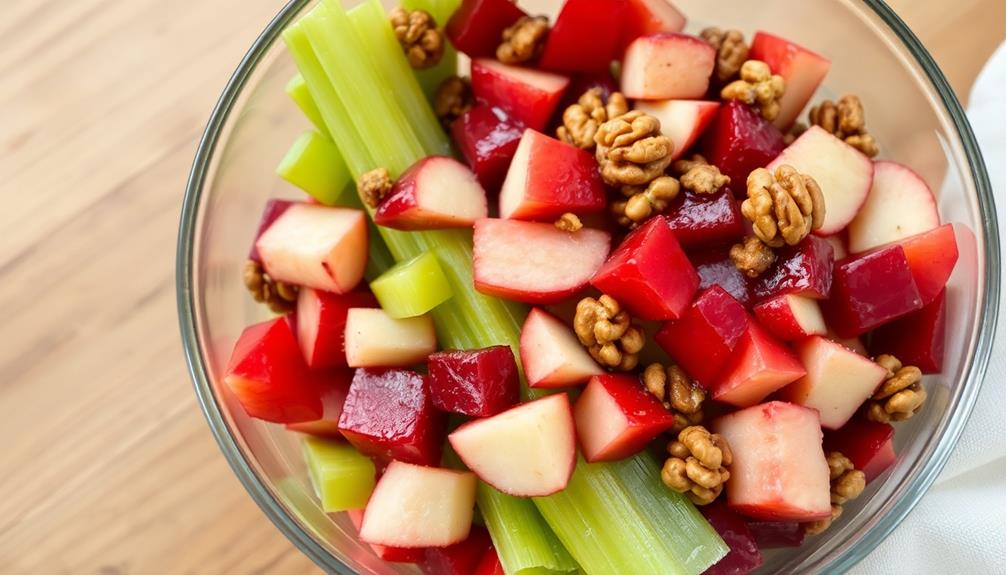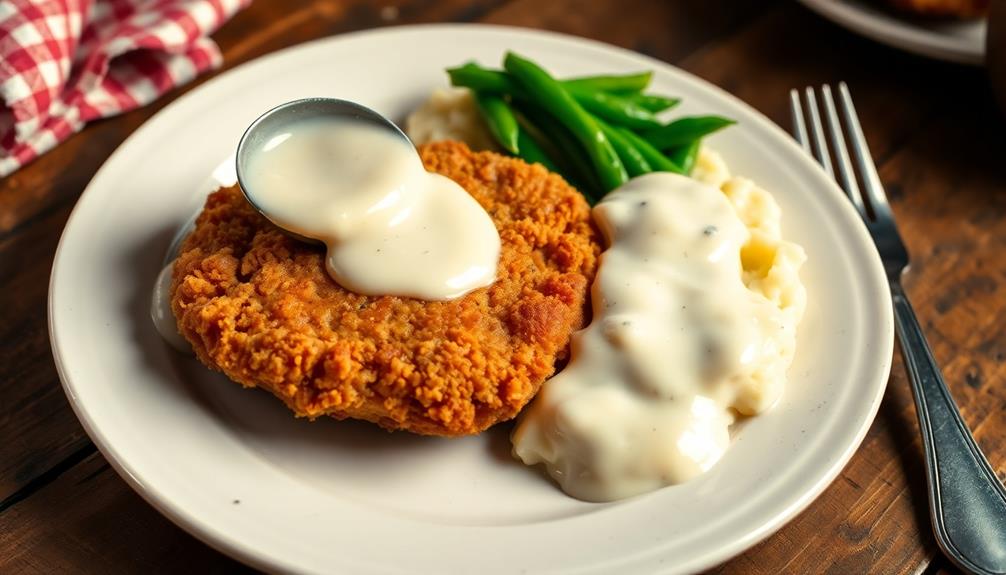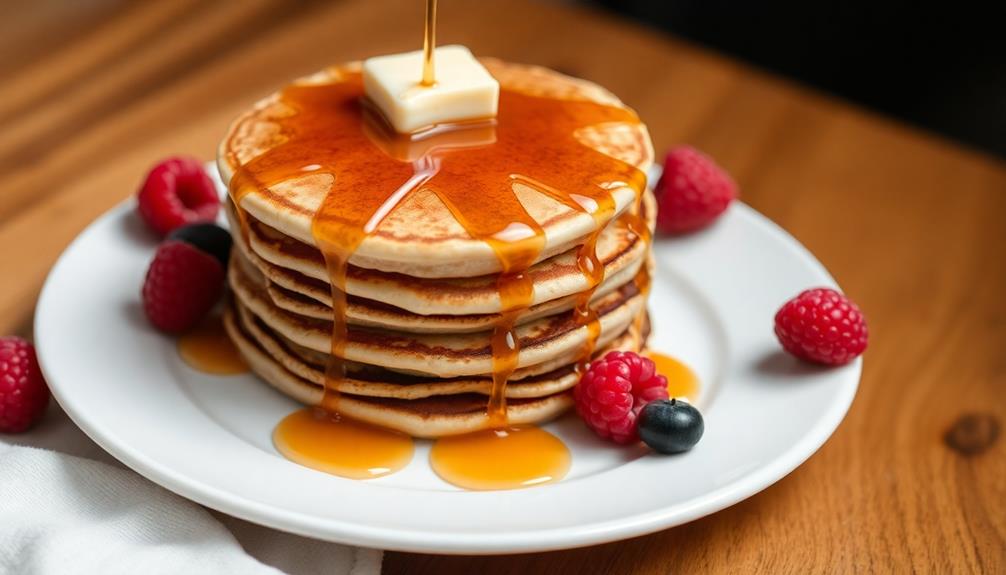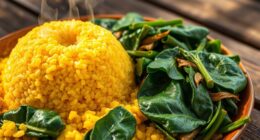Macaroni and cheese is a classic comfort food that's been delighting taste buds for centuries! It all started in Italy back in the 13th century, with delicious pasta and cheese combinations. Over the years, the dish has evolved, with Thomas Jefferson bringing a pasta machine from Italy to America in the 1700s. Today, you can enjoy macaroni and cheese in countless ways – from baking it with a crispy top to experimenting with different cheeses and seasonings. It's a timeless dish that's loved by all ages, and there's always more to discover about this beloved comfort food classic.
Key Takeaways
- Macaroni and cheese originated in Italy in the 13th century and became a comfort food classic enjoyed worldwide.
- The dish evolved over the years with various cheeses, seasonings, and baking techniques.
- Proper preparation techniques, including preheating the oven and creating a creamy cheese sauce, are crucial for achieving the desired texture and flavor.
- Experimenting with different cheese types and adding spices can enhance the dish's flavor profile.
- Sharing the homemade macaroni and cheese with others can be a joyful experience.
History
Macaroni and cheese has a rich history, dating back to the 13th century. You might be surprised to learn that this beloved dish originated in Italy, where people were enjoying pasta and cheese combinations long before it became a staple in American homes.
The earliest known recipe for something resembling modern mac and cheese was written down in the 1300s, and the dish quickly spread across Europe.
In the 1700s, Thomas Jefferson, one of the Founding Fathers of the United States, brought a pasta machine back from Italy and served a version of macaroni and cheese at a state dinner. This helped popularize the dish in America.
Over the years, mac and cheese evolved, with home cooks and chefs experimenting with different cheeses, seasonings, and baking techniques.
Today, it remains a comfort food classic, enjoyed by people of all ages around the world.
Cooking Steps
Preheat your oven to 350°F.
Now, grab a large pot and fill it with water. Bring the water to a boil over high heat. Once it's boiling, add a generous pinch of salt and the macaroni. Cook the pasta according to the package instructions, usually around 8-10 minutes, until it's nice and tender.
Drain the cooked macaroni in a colander and set it aside.
In the same pot, melt the butter over medium heat. Whisk in the flour to create a smooth paste, known as a roux. Slowly pour in the milk, whisking constantly to prevent lumps from forming. Let the sauce simmer until it thickens, about 5 minutes.
Remove the pot from the heat and stir in the shredded cheese until it's melted and the sauce is creamy.
Add the cooked macaroni and mix well. Transfer the cheesy pasta to a baking dish and sprinkle the breadcrumbs on top.
Bake for 20-25 minutes, until the top is golden brown and bubbly. Enjoy your homemade macaroni and cheese!
Step 1. Preheat Oven to 350°F
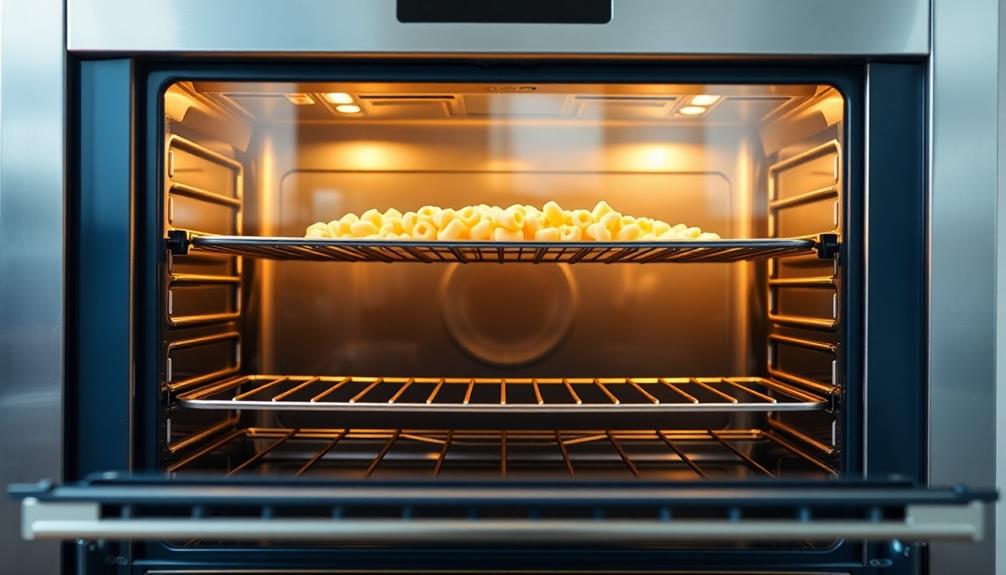
To begin the cooking process, you'll need to preheat your oven to 350°F. This is a crucial step that ensures your macaroni and cheese bakes evenly and perfectly. Set your oven to the desired temperature and give it a few minutes to fully heat up.
While you wait, you can start preparing the other ingredients.
Once the oven has reached 350°F, you're ready to move on to the next step. This even, consistent heat is essential for the cheese sauce to melt and meld seamlessly with the macaroni. The high temperature will also help create a beautifully golden, crispy top layer on your baked macaroni and cheese.
Be sure to keep an eye on the oven as it preheats, and don't forget to set a timer to remind you when it's ready. With the oven preheated, you can now begin assembling your delicious macaroni and cheese dish.
Step 2. Add Butter to Pot

Next, add 2 tablespoons of butter to a large pot.
Make sure the pot is big enough to hold all the ingredients – you don't want it to overflow!
Once the butter is in, turn the heat to medium and let it melt.
Using high-quality butter, such as grass-fed butter, will enhance the flavor of your macaroni and cheese.
Stir it around a bit with a wooden spoon to help it melt faster.
As the butter melts, it'll start to sizzle and bubble.
This is exactly what you want – the sizzling butter is going to help infuse all the other ingredients with delicious flavor.
Keep stirring the melted butter until it's fully incorporated.
It should have a rich, golden color.
Now you're ready for the next step – adding the macaroni!
This is where the magic really starts to happen.
Get ready for cheesy, creamy goodness.
Step 3. Add Cheese to Pot

After the butter has melted, it's time to add the cheese! This is where the magic really starts to happen. Grab a handful of your favorite shredded cheese and sprinkle it into the pot. Keep stirring as you add the cheese, making sure it melts evenly throughout the macaroni.
For a delightful twist, consider incorporating a sprinkle of celery juice powder for added nutrients and flavor, as it retains the beneficial properties of fresh celery known for hydration and electrolyte balance support.
The key is to go slowly and add the cheese a little at a time. This way, the cheese has a chance to fully incorporate into the sauce, creating a rich, creamy texture. You can experiment with different types of cheese, too – cheddar, Gruyère, or even a blend for extra flavor.
Once all the cheese is melted and combined, your macaroni and cheese is starting to take shape. The sauce should be smooth and velvety, coating every noodle.
Give it a taste and add any additional seasonings, like salt and pepper, to suit your personal preferences. With the cheese added, you're one step closer to cheesy, comforting perfection! If you like a little kick, you can also add a pinch of cayenne pepper or a few dashes of hot sauce. This tasty tomato soup recipe is a versatile dish that can be enjoyed on its own, or paired with a grilled cheese sandwich for a classic comfort meal. Whether you’re serving it for a cozy night in or as an appetizer at a dinner party, this soup is sure to be a crowd-pleaser.
Step 4. Add Milk and Stir

Adding the milk and stirring is a crucial step in achieving the desired creamy texture for your macaroni and cheese. Pour in the milk slowly, while continuously stirring the mixture with a wooden spoon or whisk. This helps the milk fully incorporate into the cheese, creating a smooth, velvety consistency.
Stir the pot with purpose, making sure to scrape the bottom and sides to prevent any clumps from forming. The key is to stir steadily and patiently until the sauce thickens to your liking. Don't be tempted to rush this process, as it's essential for achieving the perfect creamy texture.
Once the sauce has reached your desired consistency, you're ready to move on to the next step. Taste the macaroni and cheese, and add any additional seasonings or ingredients to customize the flavor to your preference.
With the milk and stirring complete, you're well on your way to creating a delicious, homemade macaroni and cheese dish.
Step 5. Add Pasta to Pot
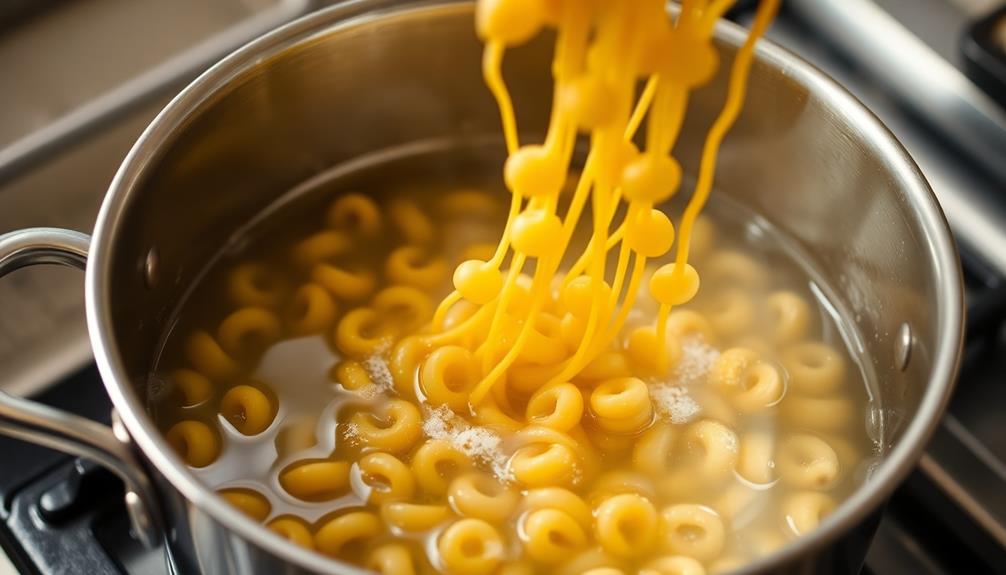
With the milk and stirring complete, you can now turn your attention to adding the pasta to the pot.
Grab the box of elbow macaroni and carefully pour it into the pot. Make sure to do this slowly, as you don't want the pasta to spill over the sides. Once all the pasta is in, give it a gentle stir with your spoon to ensure it's evenly distributed.
Now, it's time to turn on the heat. Crank the dial to medium-high and let the pot come to a boil. As the water starts to bubble, you'll see the pasta begin to soften and expand.
Keep a close eye on it, giving it an occasional stir, until the pasta is al dente – tender, but still with a slight bite to it. This should take around 7-10 minutes, depending on the type of pasta you're using.
Once the pasta is cooked to perfection, it's time to move on to the next step: draining the pot.
Carefully grab the handle of the pot and pour the contents into a colander in the sink, making sure not to lose any of those precious noodles.
Final Thoughts
Ultimately, making delectable macaroni and cheese requires more than simply following a recipe. It's about embracing the process, experimenting with flavors, and finding the perfect balance that suits your taste buds.
Don't be afraid to get creative! Try adding a pinch of paprika or a sprinkle of garlic powder to give your dish a little extra zing. And don't forget the most important ingredient – your own personal touch.
As you continue on your macaroni and cheese journey, remember to have fun with it. Experiment with different cheeses, noodle shapes, and toppings. The possibilities are endless!
Who knows, you might just discover your new favorite combination. So, dive in, get your hands a little messy, and enjoy the process. After all, the best part of making macaroni and cheese is sharing it with those you love.
Frequently Asked Questions
How Long Can Leftover Mac and Cheese Be Stored?
Leftover mac and cheese can last for 3-4 days in the fridge when stored properly.
Just make sure to keep it in an airtight container and reheat it thoroughly before eating. This way, you can enjoy your cheesy goodness for a few more days without worrying about it going bad.
Just be sure to give it a good sniff before digging in – if it smells off, it's best to toss it out.
Can I Use Different Types of Cheese in the Recipe?
Absolutely! You can use all sorts of cheeses in your mac and cheese recipe.
Try mixing cheddar with parmesan, or even adding in some gouda or gruyere for extra flavor. The possibilities are endless!
Just be sure to shred or crumble the cheese so it melts smoothly into the dish.
Experiment and have fun – that's the best part of cooking, isn't it? You never know what delicious creation you'll come up with.
What Is the Best Way to Reheat Mac and Cheese?
The best way to reheat mac and cheese is to pop it in the oven!
Preheat your oven to 350°F, then place the mac and cheese in an oven-safe dish. Cover it with foil to keep it moist, and bake for 15-20 minutes until it's hot and melty again.
You can also reheat it on the stovetop over low heat, stirring frequently to prevent sticking. Just be sure to add a splash of milk or cream to keep it creamy and delicious!
Can I Make Mac and Cheese in the Slow Cooker?
You can absolutely make mac and cheese in the slow cooker!
It's a super easy way to create a creamy, cheesy dish without all the hands-on work. Just toss your ingredients into the slow cooker, let it do its thing, and you'll have a delicious meal waiting for you when you're ready to eat.
The slow cooker keeps the cheese nice and smooth, so you don't have to worry about it drying out or getting grainy.
Give it a try – you'll love how effortless it is!
How Can I Make the Cheese Sauce Creamier?
To make your cheese sauce creamier, start by using a blend of cheeses. Sharp cheddar gives great flavor, while softer cheeses like Parmesan or cream cheese add extra creaminess.
Grate the cheese finely, then melt it slowly into your milk or cream over low heat, stirring constantly. You can also try adding a bit of cornstarch or flour to thicken the sauce.
Just be sure not to overheat it, or the cheese could get grainy. With a few simple tricks, you'll have a super creamy cheese sauce in no time!

